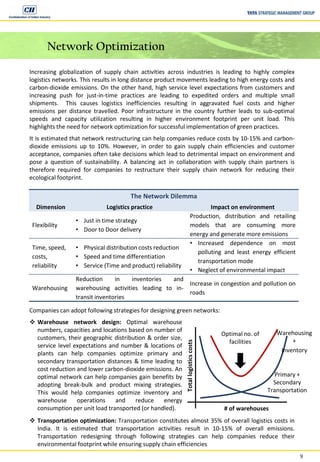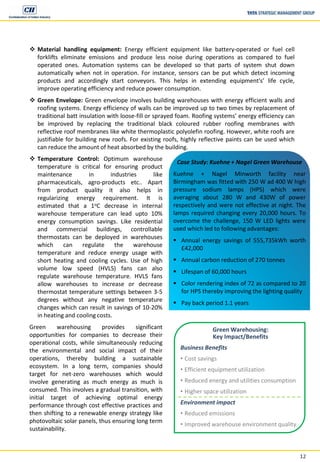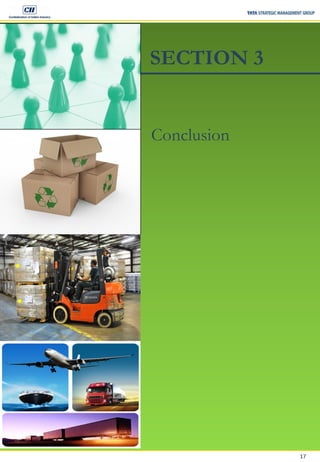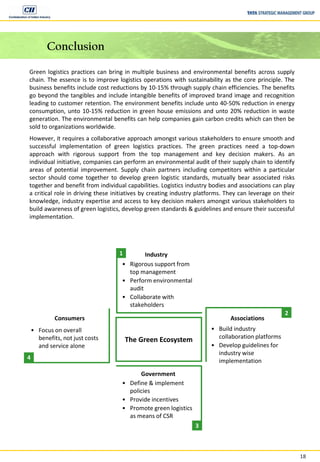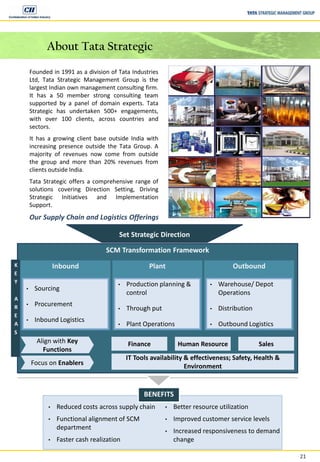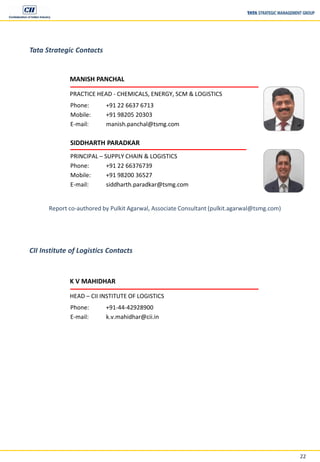CII 2014- Report on Green Logistics
- 1. 1 Ta t a S t ra t e g i c M a n a g e m e n t G r o u p Green Logistics Redesigning logistics for a better tomorrow
- 3. 3 Foreword The report on “Green logistics: Redesigning logistics for a better tomorrow” is a part of joint endeavour between Confederation of Indian Industry (CII) Institute of Logistics and TATA Strategic Management group (TSMG) Supply Chain and Logistics Practice to highlight the importance of Green Logistics. In today’s globalized economy, having a robust and flexible logistics system can be a differentiating factor leading to success or failure of business activities. Implementing Green Logistics not only gives environmental benefits but also several strategic business benefits required to differentiate existing Supply chains. Initiatives such as Network Optimization and Logistics efficiency improvements which greatly contribute in reducing the Carbon footprint also gives a competitive edge to the companies to create a more robust and responsive Supply Chain. Initiatives in Warehouses such as Innovative lighting and other Warehouse efficiency improvements along with adapting to green packaging; aids to this idea of achieving a complete Green logistics. Companies also need to work closely with environmentally responsible Supply Chain vendors and Suppliers who have a commitment towards sustainability and have significant experience in providing eco-friendly solutions. This report is being presented in the “CII Institute of Logistics: Green Logistics” conference on the 13th of November 2014. The report is a result of CII Institute of Logistics’ objective to highlight the importance of Green Logistics in national economy and opportunities present in the sector. We are thankful to CII Institute of Logistics for providing us an opportunity to develop a report which can play a pivotal role in achieving this objective.
- 4. 4 Contents Introduction to Green Logistics Key Levers for Green Logistics Network Optimization Green Warehousing Standardization Green Packaging Conclusion
- 6. 6 SECTION 1 Introduction to Green Logistics
- 7. 7 Introduction Over the years, the importance of logistics has changed from being a mere support function to obtaining strategic advantage. Logistics includes all those activities which take products from the source of raw materials to final consumer, including recycling and disposal activities. On the inbound side, timely availability and superior quality of raw materials ensures uninterrupted production to fulfil orders. On the outbound side, efficient logistics activities leads to increase in customer reach and satisfaction. Irrespective of business size, logistics activities not only help in getting the product to customer on time but also get a clear idea of requirements of different customer segments. In today’s globalized economy, having a robust and flexible logistics system can be a differentiating factor leading to success or failure of business activities. Drivers for Green Logistics However, consistent focus on meeting customer requirements in minimum time at minimum cost, has led to a neglect of social and environmental impact of logistics operations. With growing government and public concerns, companies are faced with challenge of developing businesses with lower environmental footprint. This is driving an increased need for companies to “green” their logistics operations. Green Logistics Drivers The 4C Drivers Customers ComplianceCompetitive Advantage Costs Increasing energy and fuel costs Increasing cost of waste disposal Rising consciousness of environmental impact across business activities Demand from companies for reverse logistics of after use materials Means of competitive differentiation Medium for corporate social responsibility Stringent regulations like EPA, RoHS Govt. policies for reducing the carbon footprint Green Logistics can therefore be defined as supply chain management practices and strategies that reduce environmental and energy footprint across various stages of supply chain right from procurement of raw materials to finally delivering end product to the customer. Levers for Green Logistics Logistics network (including warehouse locations & capacities, modal mix, distribution network), warehousing operations, packaging activities and material handling activities form the backbone of successful logistics operations. Hence, implementation of sustainable green practices across these four levers can help companies create a positive impact on their ecological footprint at optimum costs. The 4 levers for Green Logistics are • Network Optimization • Green Warehousing • Green packaging • Standardization
- 8. 8 SECTION 2 Key Levers for Green Logistics • Network Optimization • Green Warehousing • Standardization • Green Packaging
- 9. 9 Network Optimization Increasing globalization of supply chain activities across industries is leading to highly complex logistics networks. This results in long distance product movements leading to high energy costs and carbon-dioxide emissions. On the other hand, high service level expectations from customers and increasing push for just-in-time practices are leading to expedited orders and multiple small shipments. This causes logistics inefficiencies resulting in aggravated fuel costs and higher emissions per distance travelled. Poor infrastructure in the country further leads to sub-optimal speeds and capacity utilization resulting in higher environment footprint per unit load. This highlights the need for network optimization for successful implementation of green practices. It is estimated that network restructuring can help companies reduce costs by 10-15% and carbon- dioxide emissions up to 10%. However, in order to gain supply chain efficiencies and customer acceptance, companies often take decisions which lead to detrimental impact on environment and pose a question of sustainability. A balancing act in collaboration with supply chain partners is therefore required for companies to restructure their supply chain network for reducing their ecological footprint. The Network Dilemma Dimension Logistics practice Impact on environment Flexibility • Just in time strategy • Door to Door delivery Production, distribution and retailing models that are consuming more energy and generate more emissions Time, speed, costs, reliability • Physical distribution costs reduction • Speed and time differentiation • Service (Time and product) reliability • Increased dependence on most polluting and least energy efficient transportation mode • Neglect of environmental impact Warehousing Reduction in inventories and warehousing activities leading to in- transit inventories Increase in congestion and pollution on roads Companies can adopt following strategies for designing green networks: # of warehouses Totallogisticscosts Optimal no. of facilities Warehousing + Inventory Primary + Secondary Transportation Warehouse network design: Optimal warehouse numbers, capacities and locations based on number of customers, their geographic distribution & order size, service level expectations and number & locations of plants can help companies optimize primary and secondary transportation distances & time leading to cost reduction and lower carbon-dioxide emissions. An optimal network can help companies gain benefits by adopting break-bulk and product mixing strategies. This would help companies optimize inventory and warehouse operations and reduce energy consumption per unit load transported (or handled). Transportation optimization: Transportation constitutes almost 35% of overall logistics costs in India. It is estimated that transportation activities result in 10-15% of overall emissions. Transportation redesigning through following strategies can help companies reduce their environmental footprint while ensuring supply chain efficiencies
- 10. 10 Distribution & Route Planning: Once the warehouse locations are finalized, companies can revisit their existing distribution planning system. Selecting economical distance path (not necessarily least distance path) and optimizing order fulfilment process (through differentiated replenishment model) can help companies reduce their fuel consumption. Emphasis should also be on ensuring full container loads to increase truck loading percentage and reduce emissions per ton-km. However, this would impact speed to market, and requires companies to bring on board their customers before taking such initiatives. Supply Chain visibility: An understanding between all the nodes of Supply Chain is critical in any firm. It is a critical to optimize both Cost and Service. This sharing of information via various systems and methodologies will help companies do a better job of planning at all nodes. Companies can forecast demand with better accuracy, regularly monitor their warehouse operations & inventories, accordingly plan their distribution schedules, coordinate delivery times and minimize reverse logistics. Companies can also regularly track their fleet performance, have dynamic knowledge of their locations and identify shortest feasible transportation paths. Case Study: DHL Network Optimization In 2009, DHL helped a leading household appliances producer in Germany to develop an environment friendly supply chain. DHL redesigned company’s modal mix. Under the new solution, more than 13,000 containers arriving annually at sea ports were carried by train instead of road network to the final destination. This reduced 120 road transports each week while the transit times remained unchanged. The carbon-dioxide emissions reduced by 60 percent. Network Optimization: Key Impact/Benefits Business Benefits • Distribution & transportation efficiencies • Reduced reverse logistics • Improved fleet management Environment impact • Lower energy consumption per unit load transported or handled • Reduced emissions per ton-km Modal Mix: Indian logistics sector is heavily dependent on road network (one of the least energy efficient mode) contributing to almost 65% of total freight transport. This is because of lack of transport infrastructure and need for compressing costs and time involved to meet customer demand. While building infrastructure is cost and time consuming, companies can redesign their current modal mix within existing limitations to reduce environmental impact. Green Fleet: While trucks constitute 5% of vehicle population in India, it is estimated that they are responsible for 63% of carbon-dioxide emissions, 59% of particulate matter emissions and 46% of fuel consumption, thereby highlighting the need of green fleet management. This requires a strategic approach involving a combination of technological improvements and policy initiatives. Technological changes involve use of alternate fuels (CNG/LPG/HCNG) and improved vehicle technology (e.g. aerodynamics, weight reduction, idling reduction, reduced tire rolling resistance, improved fuel injection systems) while policy initiatives involve Government intervention to provide enforcement and incentives with focus on technology adoption and fleet modernization including retirement of vehicles, replacement of powertrains and retrofitting. Green pallets: Apart from fleet, pallets play a critical role in transportation activities. Traditionally wooden pallets are used for transporting goods as they are cheap and easy to manufacture. However, wooden pallets are fragile, non-recyclable and heavy. This results in frequent replacement & disposal of damaged pallets, and lower fuel efficiencies during transportation. On the other hand, plastic pallets are more resistant to wear & tear, have longer life, can be easily recycled thereby eliminating the need of disposal and are lighter as compared to wooden pallets leading to lower fuel consumption. This also highlights that even non-natural products can bring in sustainability and help reduce environmental footprint.
- 11. 11 Green Warehousing Warehousing (including inventory management) is one of the most critical supply chain functions, accounting for 20-25% of logistics costs. Traditionally warehousing operations involved receipt, storage and delivery of materials (raw materials, WIP, finished goods and packaging) across supply chain. However, with rising costs and increasing customer demands, the role of warehousing has shifted to providing value added services. Today warehousing operations involve break-bulk, product mixing, reverse logistics, cross-docking, late product differentiation and just in time & customized deliveries, thereby helping companies to achieve operational efficiency and high levels of customer satisfaction. However, warehousing operations involve inputs related to energy, fuel, land and buildings. Apart from impact on firm level performance, they also affect the local environment and society in form of atmospheric emissions, waste generation and noise pollution. In order to develop sustainable warehousing operations, it is essential for companies to explore and implement green initiatives. Lighting, HVAC system and material handling equipments are the largest energy users in warehouse operations. It is estimated that best warehouse energy management practices can save 40-50% of energy use without significant capital investment. Companies can adopt following means for reducing their environment impact without significant cost burden Daylighting: Natural lighting involves installation of skylights and clerestory windows which provide natural illumination in warehouses with minimum additional construction. Companies can also use light tubes made of highly reflective material to harness natural light. As natural light intensity varies across the day, a hybrid setup involving natural means and artificial lights can be used. Natural lighting, thus helps companies to reduce electricity usage, reduce carbon- dioxide emissions and improve environment quality for warehouse employees Lighting systems: Often warehouses are overlit, resulting in unnecessary energy wastage. This can be overcome by using motion sensors, especially in low traffic or non-crucial areas, which ensures that lights are turned on only when the area is in use. Moving lighting away from ceiling and closer to workers can also help reduce overall usage. Fluorescent lights can be used in place of traditional metal halide light fittings. These lights are suitable for intermittent operations and provide same amount of light with lower energy consumption (up to 50% less compared to traditional fittings) at cost effective prices. Warehouse Management: Proper warehouse management can eliminate unnecessary and repetitive operations which can reduce energy and fuel consumption. For instance, high density areas due to large product quantity in small spaces result in multiple use of forklifts. Lack of streamlined operations result in multiple handling of products making the material flow critical for ensuring energy management. Use of inventory tracking techniques like RFID can help eliminate unnecessary material handling activities, resulting in savings on energy and fuel front. Vertical warehousing (racking & storage) and vertical equipment like vertical carousels & conveyors can help companies reduce land requirement, reduce construction footprint and achieve better facility planning & higher space utilization. This helps companies in preserving natural resources, develop energy efficient buildings, reduce energy costs and overall carbon footprint. Green Warehousing Levers • Warehouse Design Daylighting Lighting systems Green buildings Vertical warehousing • Warehouse Operations Energy efficient equipments Inventory tracking techniques Temperature control
- 12. 12 Material handling equipment: Energy efficient equipment like battery-operated or fuel cell forklifts eliminate emissions and produce less noise during operations as compared to fuel operated ones. Automation systems can be developed so that parts of system shut down automatically when not in operation. For instance, sensors can be put which detect incoming products and accordingly start conveyors. This helps in extending equipment's’ life cycle, improve operating efficiency and reduce power consumption. Green Envelope: Green envelope involves building warehouses with energy efficient walls and roofing systems. Energy efficiency of walls can be improved up to two times by replacement of traditional batt insulation with loose-fill or sprayed foam. Roofing systems’ energy efficiency can be improved by replacing the traditional black coloured rubber roofing membranes with reflective roof membranes like white thermoplastic polyolefin roofing. However, white roofs are justifiable for building new roofs. For existing roofs, highly reflective paints can be used which can reduce the amount of heat absorbed by the building. Temperature Control: Optimum warehouse temperature is critical for ensuring product maintenance in industries like pharmaceuticals, agro-products etc.. Apart from product quality it also helps in regularizing energy requirement. It is estimated that a 1oC decrease in internal warehouse temperature can lead upto 10% energy consumption savings. Like residential and commercial buildings, controllable thermostats can be deployed in warehouses which can regulate the warehouse temperature and reduce energy usage with short heating and cooling cycles. Use of high volume low speed (HVLS) fans can also regulate warehouse temperature. HVLS fans allow warehouses to increase or decrease thermostat temperature settings between 3-5 degrees without any negative temperature changes which can result in savings of 10-20% in heating and cooling costs. Green warehousing provides significant opportunities for companies to decrease their operational costs, while simultaneously reducing the environmental and social impact of their operations, thereby building a sustainable ecosystem. In a long term, companies should target for net-zero warehouses which would involve generating as much energy as much is consumed. This involves a gradual transition, with initial target of achieving optimal energy performance through cost effective practices and then shifting to a renewable energy strategy like photovoltaic solar panels, thus ensuring long term sustainability. Case Study: Kuehne + Nagel Green Warehouse Kuehne + Nagel Minworth facility near Birmingham was fitted with 250 W ad 400 W high pressure sodium lamps (HPS) which were averaging about 280 W and 430W of power respectively and were not effective at night. The lamps required changing every 20,000 hours. To overcome the challenge, 150 W LED lights were used which led to following advantages: Annual energy savings of 555,735kWh worth £42,000 Annual carbon reduction of 270 tonnes Lifespan of 60,000 hours Color rendering index of 72 as compared to 20 for HPS thereby improving the lighting quality Pay back period 1.1 years Green Warehousing: Key Impact/Benefits Business Benefits • Cost savings • Efficient equipment utilization • Reduced energy and utilities consumption • Higher space utilization Environment impact • Reduced emissions • Improved warehouse environment quality
- 13. 13 Standardization Typical logistics activities involve supplier packing raw materials, loading them on trucks and transporting them to manufacturer. At manufacturer’s location, raw materials are unloaded for production activities. Finished goods are then packed, loaded on trucks and then transported to warehouses where boxes are unloaded and then stacked. The goods are then loaded on trucks and delivered to retailer, where they are unloaded, re-arranged and stacked. All these activities involve multiple permutations and combinations. Goods can be transported through various modes & capacities as individual boxes or palletized loads, handled (loading and unloading) manually or through automated equipment and can be stored either on ground or on racks. These complexities due to lack of standardization, combined with multiple supply chain stages lead to operational inefficiencies, ineffective use of manpower & space, lower truck turnaround time and safety risks leading to cost escalations and bottlenecks across the supply chain. Standardization across Racking-Handling-Trucking-Palletizing (RHTP) activities helps suppliers unitize raw materials on standard pallets and load them on standard dimension trucks using standard material handling equipments. With standardization across supply chain in place, manufacturer can easily unload the pallets with minimum product damage. As pallets are of standard dimensions, they need not be returned back to supplier. Post manufacturing, finished goods can be loaded on same pallets and transported again in standard trucks to warehouses. The palletized loads can easily be stacked on standard racks with minimum man handling. The same pallets can then be used to transfer goods to retailer. - Multiple and manual product handling - Ineffective use of manpower - Inefficient space utilization - Empty truck returns - Lower truck turnaround time + Reduced material handling + Lower manpower requirement + Improved space utilization + Reduced reverse logistics and empty returns + Reduction in loading/unloading time + Improved collaboration across supply chains Traditional supply chain Standardized supply chain Standardization across RHTP activities would eliminate the need of empty pallet returns and reduce reverse logistics across various supply chain stages, thereby reducing transportation costs and emissions. As pallets and trucks are standardized, same trucks can be used to transfer multiple products. After unloading goods at a particular warehouse, a truck can be used to transport goods of some other manufacturer (or supplier) located in warehouse’ vicinity, thereby overcoming the challenge of empty truck returns. Standardization also brings in efficiencies in terms of reduction in manual & multiple material handling, reduction of loading & unloading time, improvement in space utilization, reduces chances of product damage and creates potential for using information system at a broader scale for supply chain visibility. This standardization can help companies reduce inefficiencies associated with energy & fuel consumption and greenhouse emissions. Greenhouse gas emission 135% more 125% more Energy consumption 20 times Waste generation One-way pallets vs. Pooled pallets
- 14. 14 A key and a critical benefit of standardization is the ability to build a pooling and hiring system. This helps companies to control their costs in terms of capital expenditure, equipment storage, and repair & maintenance. It can also help in developing the much needed 3PL industry. This would ensure that companies focus on their core activities, while outsourcing labour and operational activities required for logistics operations. Through pooling and hiring activities, standardization can help companies optimize life cycle impact of their equipment which would in turn translate into green logistic activities. The basic purpose of standardization is to ensure free and smooth flow of goods across supply chain. Hence, it is essential to ensure that standards across racking, material handling, trucking and palletization are compatible with each other. This requires a collaborative approach amongst various stakeholders (in the end to end supply chain) to develop standards, enable acceptance and ensure smooth transition from existing to new infrastructure systems. Standardization: Key Impact/Benefits Business Benefits • Synchronized supply chain with better visibility and lower operational costs • Improved truck and material handling equipment utilization • Development of pooling and hiring system Environment impact • Lower environment footprint per unit load transported or handled • Lower waste generation Case Study: Henkel-Chep pallet pooling Henkel, a leading laundry & home care, beauty care and adhesive technology provider has recently signed a contract with Chep, the leading provider of pallet pooling solutions to reduce its environmental impact. Under the contract, Henkel would switch to Chep’s pooled pallets at its laundry and home care products facility in Germany. Based on life cycle assessment study, it is estimated that through pallet pooling Henkel would achieve following benefits: • Annual carbon-dioxide emissions reduction by 895 MT (equivalent of annual emissions resulting from electricity used by 123 homes) • Annual waste wood reduction by 76 MT
- 15. 15 Green Packaging Traditionally packaging functions involved protection & preservation, transportation, material handling, warehousing and storage. However, over the years, with emphasis on sales promotion, customer attention, brand communication and product differentiation packaging operations have gained prominence. Packaging thus plays an integral role in ensuring smooth and successful logistics and marketing activities. Packaging also is a significant cost driver accounting for 5-12% of overall costs across supply chain of various industry sectors. However, packaging results in significant environment problems. Various kinds of materials like wood, glass, metals, paper & board and plastics are used for packaging applications with varied degree of recyclability. This results in waste generation across various stages of supply chain leading to reverse logistics and waste disposal. It is estimated that packaging contributes to 4-8% of total carbon emissions across supply chain of various industry sectors. This highlights the importance of developing green packaging solutions for achieving cost efficiencies and reducing environmental footprint. Raw materials are packaged Procurement Raw materials are unpackaged Finished products are packaged Factory Warehouse/ Distributor Products are unpackaged Repacking for smaller deliveries Products are unpackaged for consumption Consumer Packaging waste generation Typical packaging practices across supply chain stages Green Packaging involves developing environment friendly packaging solutions. It also takes into consideration ecological footprint of a product across its life cycle. The aim is to develop long term sustainable packaging solutions while considering associated cost-benefit. Green packaging thus provides companies opportunities to increase their revenues, reduce costs, streamline their supply chain and achieve intangible benefits like brand recognition and customer preference. In order to develop green solutions, companies need to explore options which are inherently green and sustainable. This involves a 3R strategy involving – Reduce, Reuse and Recycle Reduce: This involves using light weighing, less toxic & thin packaging material, eliminating excess/unnecessary packaging and bulk packaging in primary distribution, while ensuring product safety during various stages of distribution. This would result in reduction in packaging and transportation expenses, reduction in waste generated & disposal challenges across supply chain, better cube utilization and less generation of greenhouse emissions due to weight reduction.
- 16. 16 Reuse: This involves reusing packaging material resulting in improved life cycle performance, reduction in packaging inventory & improved warehouse utilization and reduction in waste management costs. However this requires weighing the benefits of reusing packaging material with respect to costs and complexity associated with reverse logistics. 3R Green Packaging Strategy The road to Green Packaging Present Long TermMedium TermImmediate Term Cost effectiveness strategy Resource efficiency Resource recovery solutions Use of low impact materials Case Study: Pepsico Green Packaging Solutions Over the last five years, PepsiCo has reduce packaging weight of its products. The Aquafina team in USA manufactures bottles consuming half the amount of plastic as compared to 2002 bottles. This has reduced plastic consumption by more than 135 million pounds. Pepsico is also actively involved in recycling packaging material. Since 2010, the company has added more than 5,000 recycling systems across North America. Pepsico’s green packaging solutions led to following benefits: • 350 million pound packaging weight reduction over last five years • 196 million beverage containers recycled since 2010 • 10% recycled PET used in manufacturing soft drink bottles in USA Recycle: This involves deploying recyclable packaging materials like paperboard, corrugated cartons, glass and bio-polymers resulting in reduction of carbon footprint, energy savings and reduction in use of natural virgin resources while upholding requisite packaging standards with no harmful impact on health and safety standards. For instance, it is estimated that recycling of each ton of paperboard results in saving 14 trees and reduction in energy consumption by 50% as compared to manufacturing virgin grades. To implement green solutions companies can undertake a phased strategy approach. From the current cost-effectiveness strategy involving meeting performance requirements and customer needs at minimum costs, companies can transition to achieving resource efficiency. This involves minimizing the use of materials and maximizing energy efficiency. The companies can then transition to resource recovery solution which involves developing designs for reusing packaging material and educating customers about proper recovery/returns strategy. Finally the companies can move to using low impact materials. This involves use of environmentally benign and renewable/recyclable materials while incorporating life cycle impact of materials used. Additionally companies need to work closely with environmentally responsible packaging suppliers who have a commitment towards sustainability and have significant experience in providing eco- friendly solutions. Green Packaging: Key Impact/Benefits Business Benefits • Improved packaging material utilization/ reduced inventory • Lower waste disposal costs • Brand recognition Environment impact • Lower waste generation and disposal • Improved life cycle performance of packaging material • Lower energy consumption
- 18. 18 Conclusion Green logistics practices can bring in multiple business and environmental benefits across supply chain. The essence is to improve logistics operations with sustainability as the core principle. The business benefits include cost reductions by 10-15% through supply chain efficiencies. The benefits go beyond the tangibles and include intangible benefits of improved brand image and recognition leading to customer retention. The environment benefits include unto 40-50% reduction in energy consumption, unto 10-15% reduction in green house emissions and unto 20% reduction in waste generation. The environmental benefits can help companies gain carbon credits which can then be sold to organizations worldwide. However, it requires a collaborative approach amongst various stakeholders to ensure smooth and successful implementation of green logistics practices. The green practices need a top-down approach with rigorous support from the top management and key decision makers. As an individual initiative, companies can perform an environmental audit of their supply chain to identify areas of potential improvement. Supply chain partners including competitors within a particular sector should come together to develop green logistic standards, mutually bear associated risks together and benefit from individual capabilities. Logistics industry bodies and associations can play a critical role in driving these initiatives by creating industry platforms. They can leverage on their knowledge, industry expertise and access to key decision makers amongst various stakeholders to build awareness of green logistics, develop green standards & guidelines and ensure their successful implementation. The Green Ecosystem 1 2 3 4 Industry Associations Government • Focus on overall benefits, not just costs and service alone • Rigorous support from top management • Perform environmental audit • Collaborate with stakeholders • Build industry collaboration platforms • Develop guidelines for industry wise implementation • Define & implement policies • Provide incentives • Promote green logistics as means of CSR Consumers
- 19. 19 The Government also has an important role in ensuring transition to green logistics. By defining clear polices and ensuring their execution, Government can play a pivotal in ensuring implementation of green logistics practices. However, the laws and timelines of implementation should be defined in consultation with various stakeholders. Various incentives like promoting green logistics as a means of CSR, standardization upgradation fund and purchasing support fund can be established to promote design, development and discharge of green practices. Periodical surveys should be carried out for evaluating policy effectiveness, green practices efficiency and benefits generated. Finally, green logistics requires support from consumers as well. Instead of focussing on costs and service level alone, consumers should look for overall benefits which green logistics brings across various stages of supply chain. Green logistics combines together company profits, human health and ecological well-being across various stages of the supply chain, with potential of building sustainable supply chains. It therefore is the way forward for logistics industry.
- 20. 20 Sources 1. Green Logistics White Paper by Tata Consultancy Services 2. Reverse Logistics and Green Logistics, Sabina Nylund 3. Supply Chain Cost Reduction in India, AQUA MCG 4. India Infrastructure Report, 2013 5. Green Freight India Seminar 2012 Summary Report 6. Green Supply Chain Network website 7. Seven trends in sustainable warehouse design, Supply Chain 247 website 8. 9 Warehouse Retrofits to Go Green and Reduce Energy Consumption, Warehouse Management Systems Guide website 9. Warehouse/DC Operations: Why sustainable design still matters, Logistics Management website 10. Interview on RHTP, Logistics Times magazine, April 2014 edition 11. GMA/FPA Conference 2007 Report 12. Simultaneous Sustainability and Savings, Accenture 13. World Trade Magazine (WT100) 14. TSMG database 15. Primary interaction with industry experts
- 21. 21 About Tata Strategic Founded in 1991 as a division of Tata Industries Ltd, Tata Strategic Management Group is the largest Indian own management consulting firm. It has a 50 member strong consulting team supported by a panel of domain experts. Tata Strategic has undertaken 500+ engagements, with over 100 clients, across countries and sectors. It has a growing client base outside India with increasing presence outside the Tata Group. A majority of revenues now come from outside the group and more than 20% revenues from clients outside India. Tata Strategic offers a comprehensive range of solutions covering Direction Setting, Driving Strategic Initiatives and Implementation Support. Our Supply Chain and Logistics Offerings • Reduced costs across supply chain • Functional alignment of SCM department • Faster cash realization • Better resource utilization • Improved customer service levels • Increased responsiveness to demand change BENEFITS Set Strategic Direction SCM Transformation Framework K E Y A R E A S Inbound • Sourcing • Procurement • Inbound Logistics Plant Outbound • Production planning & control • Through put • Plant Operations • Warehouse/ Depot Operations • Distribution • Outbound Logistics Finance IT Tools availability & effectiveness; Safety, Health & Environment Human Resource SalesAlign with Key Functions Focus on Enablers
- 22. 22 Tata Strategic Contacts MANISH PANCHAL PRACTICE HEAD - CHEMICALS, ENERGY, SCM & LOGISTICS Phone: +91 22 6637 6713 Mobile: +91 98205 20303 E-mail: manish.panchal@tsmg.com SIDDHARTH PARADKAR PRINCIPAL – SUPPLY CHAIN & LOGISTICS Phone: +91 22 66376739 Mobile: +91 98200 36527 E-mail: siddharth.paradkar@tsmg.com Report co-authored by Pulkit Agarwal, Associate Consultant (pulkit.agarwal@tsmg.com) CII Institute of Logistics Contacts K V MAHIDHAR HEAD – CII INSTITUTE OF LOGISTICS Phone: +91-44-42928900 E-mail: k.v.mahidhar@cii.in
- 23. 23 About CII Green logistics practices can bring in multiple business and environmental benefits across supply The Confederation of Indian Industry (CII) works to create and sustain an environment conducive to the development of India, partnering industry, Government, and civil society, through advisory and consultative processes. CII is a non-government, not-for-profit, industry-led and industry-managed organization, playing a proactive role in India's development process. Founded over 118 years ago, India's premier business association has over 7100 members, from the private as well as public sectors, including SMEs and MNCs, and an indirect membership of over 90,000 enterprises from around 257 national and regional sectoral industry bodies. CII charts change by working closely with Government on policy issues, interfacing with thought leaders, and enhancing efficiency, competitiveness and business opportunities for industry through a range of specialized services and strategic global linkages. It also provides a platform for consensus building and networking on key issues. Extending its agenda beyond business, CII assists industry to identify and execute corporate citizenship programmes. Partnerships with civil society organizations carry forward corporate initiatives for integrated and inclusive development across diverse domains including affirmative action, healthcare, education, livelihood, diversity management, skill development, empowerment of women and water, to name a few. The CII Theme for 2013-14 is Accelerating Economic Growth through Innovation, Transformation, Inclusion and Governance. Towards this, CII advocacy will accord top priority to stepping up the growth trajectory of the nation, while retaining a strong focus on accountability, transparency and measurement in the corporate and social ecosystem, building a knowledge economy, and broad-basing development to help deliver the fruits of progress to all. About CII - Institute of Logistics To address the need of sharpening India Inc’s competitive edge through better Logistics and Supply Chain practices, CII Institute of Logistics (CIL) was established in 2004 by the Confederation of Indian Industry as a Center of Excellence in Logistics and Supply Chain. At CII Institute of Logistics we create a platform for the Industry to gain more insights into the emerging trends, industry specific problems of national importance and global best practices in logistics and supply chain management. We enable the industry to cut down the transaction cost, increase efficiency, and enhance profitability and enable to sensitize and bring solutions to macro level issues. With a relentless aspiration to enhance logistics competitiveness in the industry, CIL provides a complete range of services such as: ∙ Events ∙ Education ∙ Training ∙ Advisory Services ∙ Research& Publication
- 24. 24








